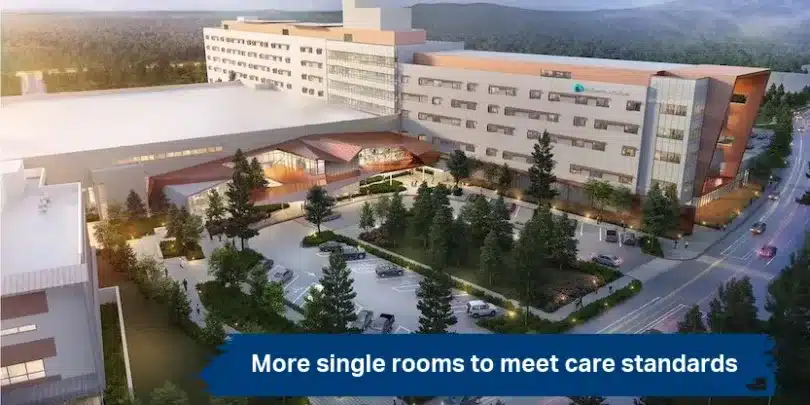Northern Arizona Healthcare (NAH) is planning a hospital where every patient who is admitted can receive care in a private room. Single-occupancy hospital rooms are the standard of care across the country and the standard of care northern Arizona deserves.
NAH is planning for the future of health care, and our outdated facility is reminiscent of health care’s past. Flagstaff Medical Center has 74 beds in shared rooms, where two people must get their care side by side, overhearing everything about one another’s situation, including protected health information.
None of the rooms at Flagstaff Medical Center (FMC) meet the Arizona Department of Health Services’ current requirements for size and infrastructure needs. Our ICU rooms don’t all have access to natural light and none of them have bathrooms, both of which are current standards for intensive care rooms.
As we plan a new hospital, we are including more beds and all of them in single, private rooms that meet state standards for care.
Private rooms improve health and healing
Our plans for a new hospital north of Fort Tuthill, near I-17 and I-40, transform the hospital experience for northern Arizona, as everyone who needs an inpatient stay will be able to get their care in a private room.
NAH’s mission is to improve health and heal people. Medical studies have shown disruptive noise is counter to a healing environment. Hearing everything that’s happening in your roommate’s course of care is not the best way to achieve the rest and calm that the body needs to heal.
NAH sends a survey to every patient who stays in our hospitals, and those who have stayed in FMC units with single-occupancy rooms report much quieter environment than those on floors with shared rooms.
Our data is similar to surveys of patients throughout the country. Those who have a roommate in the hospital report lower confidence in understanding their new medications, worse communication with their care team and they rate their overall experience lower than those who get care in single-occupancy rooms.
Infection prevention is a key measure of a hospital’s quality, and one Flagstaff Medical Center is excelling at, having been ranked No. 1 in the state for avoiding transmission of what are known as hospital-acquired infections. However, when we have to isolate a patient as we await results of a lab test for infection, we cannot put them in shared room, which often means they go in a double room and we cannot use the other bed.
Many people are unaware that our Special Care Nursery, which cares for babies who need intensive medical care, is one of the locations where numerous patients and their families share an open space. Babies in isolettes are a few feet away from one another. When you add nurses and family to the tight quarters, it can become difficult to even move around, let alone have a private moment with your medically-fragile baby or discuss difficult decisions with a doctor. In the new hospital, babies will have private rooms where a parent can stay overnight with them. This is another proven method to accelerate healing.
The list goes on, but data clearly shows shared hospital rooms are not the best route to healing. By building 100% private rooms in our new hospital, we take another step toward fulfilling our mission for northern Arizona.
More beds right away, room to add capacity as needed
When we open the hospital, it will have 24 more beds than FMC has today. But, because we’re also optimizing efficiency in the Emergency Department and building a special area to improve the process for patients who are about ready to be discharged, we will be able to accommodate 26% more patients than the current FMC campus on the day the hospital opens.
A more efficient and better coordinated facility will help shorten patients’ average length of stay, which will allow each bed to accommodate more patients per year.
That’s critical, as thousands of people have to leave northern Arizona and go to Phoenix, Las Vegas or Albuquerque each year to get care because FMC just doesn’t have the space for them.
Once open, as soon as we forecast a need for more beds we will be able to expand the new hospital capacity to add 44 beds within one year on the new site, without purchasing new land or moving.
Even farther into the future, when the region needs additional beds, the hospital structure will be designed so we can add a third patient tower to the existing facility.
We are planning a hospital that can grow as the communities of northern Arizona grow. While Flagstaff growth is limited due to its geography, all of the other northern Arizona cities are expected to grow rapidly in the coming decades.
The regional population served at the FMC Level I Trauma Center is expected to double by 2050, according to Maricopa Association of Governments population projections. We have to plan for this growth, and our new hospital accommodates that continued growth for the next several decades. Our current site cannot do so.
Please see our article on why we can’t renovate FMC.
